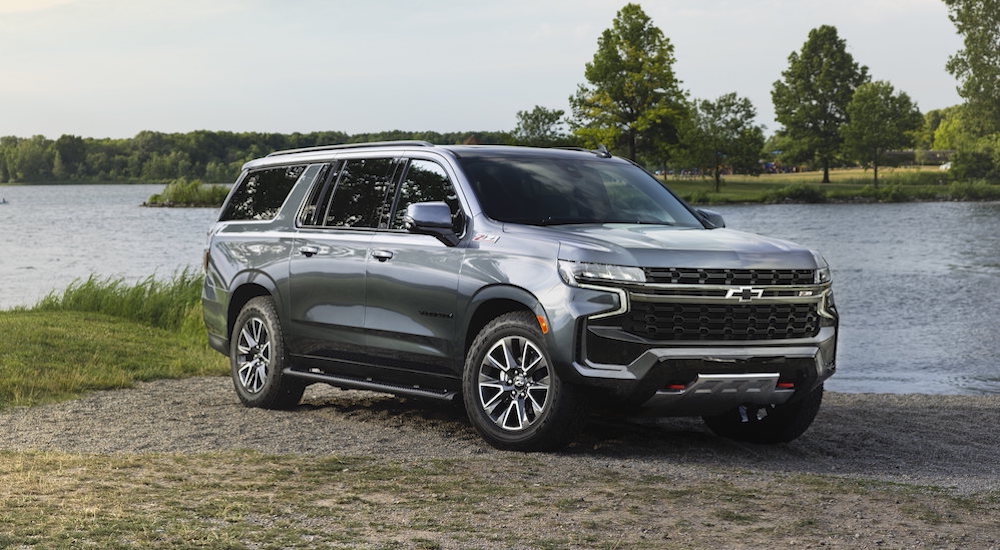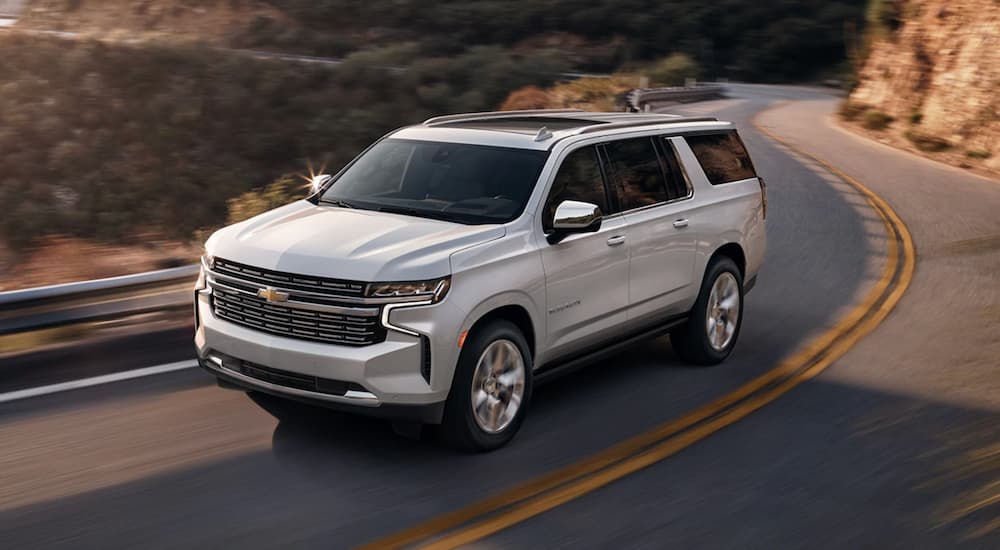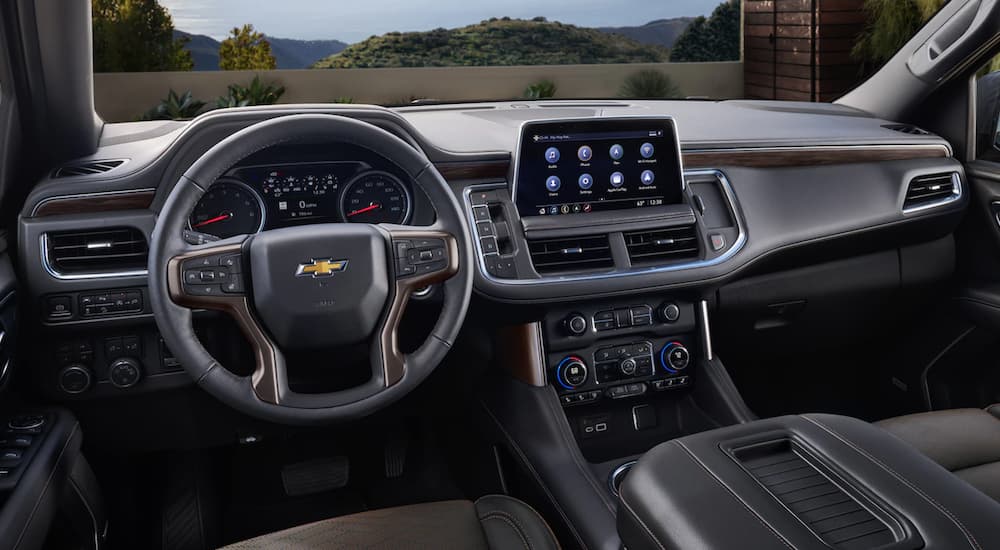
Few vehicles embody the spirit of the full-size SUV quite as well as the Chevy Suburban. This colossal carryall has been one of General Motors’ biggest success stories, with the auto giant producing more than two million units since the model first debuted back in 1935. The deeper you look, the more the plaudits start to pile up. Thanks to its heavy-duty, body-on-frame construction, this SUV is now revered for its reliability, with a 2018 survey finding that the Suburban racks up more miles every year—14,862 on average—than any other vehicle on the road. Named the second longest-lasting vehicle in a 2019 study by iSeeCars.com, it’s no surprise how easy it is to find a used Suburban for sale.
While the Suburban might seem like a modern success story, its history stretches back much further than many might realize. In fact, the Suburban is the longest continuously used automobile nameplate in production today. Drivers as far back as the 1930s might recognize the Suburban name, but the vehicle itself is another story altogether. The Suburban is also no stranger to the silver screen, with over 1,750 film and TV appearances under its belt and a star on the Hollywood Walk of Fame to boot.
This legendary SUV has gone through quite an evolution over the last century, transforming from an all-metal station wagon into the roomy full-size SUV we know today. Join us as we take a closer look at how the Suburban has changed over the years, blossoming from a reliable family vehicle into the crown jewel of the full-size SUV class.

Something a Little Different
These days, the name “Suburban” immediately conjures up images of the mammoth three-row SUV, but that hasn’t always been the case. In fact, the word “Suburban” was once used to refer to a specific type of windowed station wagon built on a full-size commercial truck frame. The design was popular in the 1930s, with automakers from DeSoto to Dodge, Plymouth, Studebaker, and more all producing their own Suburban-style vehicle throughout the decade.
The name was technically owned by the US Body and Forging Co. of Indiana, which supplied automakers with the wooden station wagon bodies that made a Suburban such a popular choice in Depression-era America. It was basically its own class of vehicle, which begs the question: how did Chevy come to trademark the Suburban name for itself?
In order to understand the Suburban’s genesis, we have to travel to the early 1930s. With World War I just a decade in the past and the Great Depression in full swing, Americans were looking for a well-rounded vehicle that could accommodate plenty of passengers and cargo without breaking the bank. It also had to be sturdy and able to tackle the rutted dirt roads, pockmarked city streets, and other challenges of its time.
Chevy first experimented with an eight-seat, wood-bodied concept built on a light truck chassis in a deal with the Civilian Conservation Corps (CCC) and National Guard in 1933, but this design failed to meet some important benchmarks when it comes to toughness. The vehicle’s wood bodywork wasn’t tough enough to withstand the rigors of 1930s life, leading Chevy engineers to make a change that would revolutionize the Suburban design for years to come.
Chevy ditched the traditional wood body for a full-steel version, giving the 1934 Suburban Carryall a major leg-up over the competition. While the early Suburban was still reserved for the CCC and National Guard, it won some favorable public reviews, inspiring Chevy to release a version to the general public in 1935. Powered by a six-cylinder engine outputting 60 hp, the Suburban Carryall was a spacious people-mover that would still do today’s version proud with seating for eight passengers across three rows. A rear folding tailgate and removable rear seats made it easy to transform the Suburban Carryall into more of a cargo-focused vehicle, offering a level of versatility that went a long way among a cash-strapped populace. The Suburban was off to a good start, bringing something unique to the market with its all-steel design and setting the stage for continued success.
Creating the SUV
The first-generation Suburban Carryall was followed up with a new version in 1941. Chevy rolled out a four-door model and upped the model’s horsepower by some 50%, giving drivers 90 hp to play with. The Suburban Carryall proved just as popular in wartime as it had been in the relatively peaceful decade that preceded WWII, becoming an important part of the Allied war effort as a reliable troop transport. The Suburban Carryall’s military service would be a real boon for the nameplate after the war, as returning troops flocked to the familiar model in droves. Some ex-military, second-generation models were sold to regular consumers as surplus, but Chevy soon went to work on the third-generation Suburban Carryall, which debuted in 1947.
Based on Chevy’s new Advanced Design light truck series, the third-gen Suburban Carryall was basically a half-ton pickup that rode low to the ground and prioritized cargo space over raw power. The new Suburban Carryall shared the same inline-six engine as its predecessor for much of the third-gen run, but the power plant was replaced with a similarly powerful 3.9L “Thirftmaster” inline-six in 1954. Paired with their three- or four-speed manual transmission, the Thriftmaster had a lot in common with the iconic “Blue Flame” engine that would become the centerpiece of the first-gen Chevy Corvette.
The Suburban Carryall would see some subtle design changes and engine upgrades throughout its fourth, but the biggest change would come in 1957 when Chevy introduced four-wheel drive to the model for the first time. This important upgrade allowed the Suburban Carryall to traverse new terrain, making it the go-to choice for agricultural and industrial customers, hunters, and other breeds of sportsmen. As soon as it was outfitted with four-wheel drive, the Suburban Carryall became one of the most unique vehicles on the market, forcing critics to create an entirely new category, designating the Suburban the industry’s first Sports Utility Vehicle, or SUV.
Chevy would continue to innovate their way to success, giving the Suburban Carryall a fully independent front suspension, wraparound windshield, and a new V6 engine in 1960 and disc brakes in 1970. The V6 is particularly noteworthy as it was one of the first such engines produced by a US manufacturer, providing 150 hp and giving the Suburban Carryall the type of unrivaled power that would soon become its trademark.
The seventh-generation Suburban, produced between 1973 and 1991, was the longest-running iteration to date. Chevy wasn’t about to mess with success, allowing the Suburban’s reputation to carry it through the decades while making some modest changes along the way. The most notable of these would be the introduction of two diesel V8 engines, which went a long way in alleviating the public’s aversion to gas-guzzling vehicles following the 1973 oil crisis. It was also around this time that Chevy took sole possession of the Suburban name. The Plymouth Fury Suburban—its only remaining competitor for the trademark—was discontinued in 1978, and GM was finally awarded the Suburban trademark in 1988.
With the introduction of the eight-generation in 1992, the Suburban began to take on a look that many of today’s drivers will start to recognize. Created by iconic automotive designer Chuck Jordan, who styled such classics as the Cadillac Eldorado and 1992 Cadillac Seville, the eighth-gen Suburban carried a decidedly modern look, along with a lot of new hardware under the hood such as a leaf spring rear suspension with a live axle, ABS brakes, turbocharged V8, and more. This generation would also see the introduction of the Holden Suburban, a right-hand drive version designed for the Australian market.
As we moved closer to the modern day, some important changes were coming for the Suburban. First off, GM spun off a new version of GMC dubbed the Yukon XL, a slightly smaller full-size SUV that put an emphasis on including more luxury features. The second change was the introduction of Chevy’s Vortec 5300 engines. With the ability to output 295 hp and 335 lb-ft of torque, these engines gave the SUV all the power it needed to hold its crown in the full-size segment. The tenth-generation Suburban offered a less boxy design than many of its predecessors, providing a more aerodynamic, modern shape in response to changing tastes. The eleventh-gen Suburban, built on the GMT K2XX platform, would continue the trend of introducing more modern technology into the legendary SUV. From the EcoTec3 V8 with direct fuel injection that delivers some 355 hp to automated driver assistance and safety features like Lane Departure Warning, Front Parking Assist, and a Forward Collision Alert, the Suburban would serve as the ideal testing ground for some exciting innovations.

Continuing a Legacy
The 2023 Chevy Suburban builds on the attributes that have made the full-size SUV such a popular choice over the years. Spacious, with seating for eight and unrivaled cargo capacity, the 2023 Suburban boasts over 145 cu.ft. of storage space throughout the cabin. That’s an exceptional number, even in the full-size SUV category, where cargo space is often a focal point. The Suburban routinely bests some of its rivals by as much as 20 cu.ft. thanks in part to its independent rear suspension, which allows for a lower, smoother load floor than many other vehicles in its class.
Of course, all that cargo capacity comes at a price, with the massive SUV weighing in at some 6,000 lbs. Luckily Chevy has outfitted the Suburban with a brawny set of engines that will never leave drivers lacking for power. When equipped with the standard 355 hp, 5.3L V8 engine, the Suburban can tow an impressive 8,300 lbs in its rear-wheel drive configuration, which should be more than enough for even some of the biggest campers, boats, or trailers. Those seeking unrivaled power should look into the available 6.2L V8, which churns out an impressive 420 hp, or the 3.0L, six-cylinder turbodiesel, which packs 460 lb-ft of torque beneath the hood.
All that power is nice, but it doesn’t amount to much if the ride quality can’t keep up. Full-size SUVs built in the traditional body-on-frame style are known for delivering a bumpier ride than the new generation of unibody crossover SUVs, but Chevy has engineered around this common issue by offering the 2023 Suburban with available adaptive dampers and an air suspension that can be adjusted either automatically or manually. This adjustable air suspension not only allows drivers to improve ease of access when it comes to the towering SUV but can also go a long way in addressing the Suburban’s aerodynamics and ground clearance.
Chevy has rolled out a unique slate of Suburban trims for 2023, including a sporty RST option with 22-inch wheels and blacked-out exterior styling, but if off-road performance is your thing, look no further than the Z71 trim. Equipped with 20-inch wheels wrapped in Goodyear Wrangler TrailRunner AT, the Z71 Suburban is ready for whatever the trail might throw at it with protective underbody skid plates and a two-speed transfer case that delivers exceptional four-wheel drive performance.
Since its earliest days, the Chevy Suburban has always been a little hard to pigeonhole. Not satisfied with the wood body construction that was so common to the station wagon class, Chevy broke the mold right out of the gate by opting for a unique, all-steel design. That spirit of innovation has made the Suburban a true automotive success story over the decades, earning its stripes on the battlefield and returning home to become one of the most popular models in post-WW2 America. The Suburban has always been a standout when it comes to cargo and passenger capacity, but it was the introduction of four-wheel drive in 1957 that would put the fledgling SUV in the history books while creating an entirely new type of vehicle in the process.
The competition has heated up over the decades, with dozens of full-size SUVs coming for the Suburban’s crown; so far, however, few have managed to match the original sport utility vehicle in terms of pure power, space, and luxury. Even the recent crop of unibody crossover SUVs haven’t been able to dethrone the body-on-frame Suburban, which will likely go down in history as one of Chevy’s greatest contributions to the auto world.




